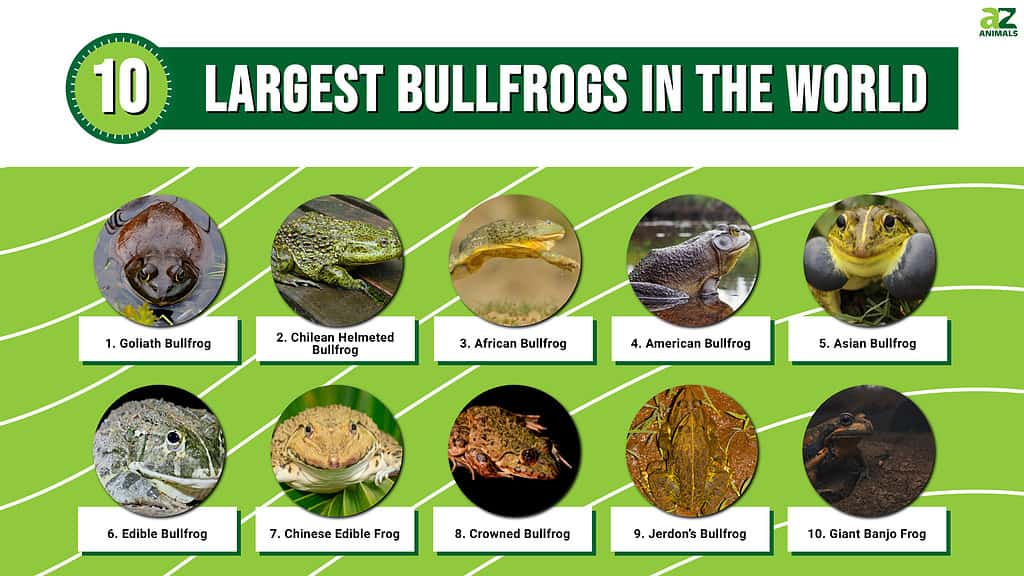
There are over 5000 frog species in the world. Each species has varying traits. Size, color, and location are some of the differences you can find between them. Frogs are amphibians, and many need an aquatic habitat to breed and keep moist. Frogs come in many different sizes, and some even grow to the size of a small cat. Insects are what frogs usually eat, but some larger species can prey on birds, snakes, bats, and even small rodents.
One of the largest and most dominant types of frog is the bullfrog. Bullfrog is a term used to describe many giant, aggressive, and dominant frogs worldwide. One of the most popular is the American bullfrog, but this is just one of many. The cane toad is a frog considered a Bullfrog, but only in the Philippines do they call it that.
Bullfrogs are one of the largest types of frogs and are usually the dominant species where they are present. Their sizes give them the advantage compared to other frogs, and why bullfrogs tend to become invasive in non-endemic regions. Being so large is also why they are considered a prime food choice for people who enjoy eating frogs.
Here we will cover ten enormous bullfrogs globally, which are also some of the largest frog species. Vent to snout is how the size of frogs is measured. Asia, Africa, Australia, and the Americas are the regions they inhabit. Female frogs are usually bigger and heavier, but that may differ depending on the species. Let’s learn about the largest bullfrogs in the world.
10. Giant Banjo Frog (Limnodynastes interioris)
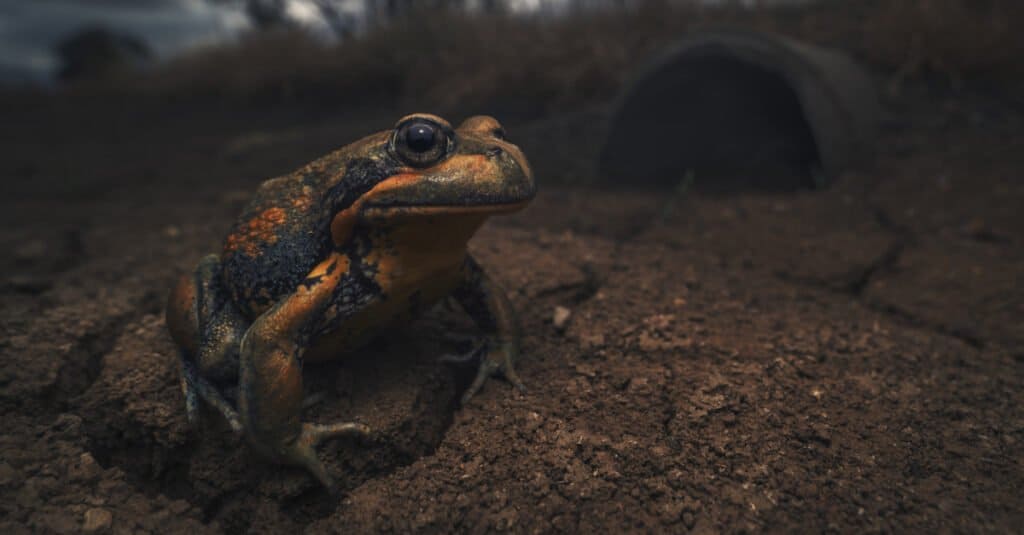
Giant banjo frogs reach 3.5 inches.
©Kristian Bell/Shutterstock.com
The Giant Banjo Frog is a burrowing species endemic to Australia. They are also called the giant bullfrog, or great bullfrog. This species lives in forests, swamps, savannas, and grasslands. Giant banjo frogs live in moist or dry environments next to a freshwater source like a lake, pond, river, or swamp. They spend the majority of their life underground but will emerge in heavy rainfall to breed.
Even being the smallest frog on this list, they can reach a length of 3.5 inches (90 mm.) as an adult. They have round bodies and short legs optimized for digging. Colors range from pale yellow to brown, and they are covered in white dots on their side, and yellow markings appear on their chest and sides.
Insects are the main diet of the giant banjo frog. They are common in Victoria, Australia, and don’t have a range outside the island. Habitat loss is the biggest threat they face, but they still have a healthy population.
9. Jerdon’s Bullfrog (Hoplobatrachus crassus)

Female Jerdon’s bullfrogs reach 3.9 inches.
©RealityImages/Shutterstock.com
Jerdon’s Bullfrog inhabits eastern India, as well as Sri Lanka, Nepal, and Bangladesh. This species lives in grasslands and open plains. The South Indian Bullfrog is also another common name for them. As adults, they spend most of their time in burrows. In dry seasons they will aestivate, becoming dormant. Water is necessary for their survival and breeding. They can tolerate waters with higher salinity.
Females are capable of reaching up to 3.9 inches (10 cm), and males are only able to grow a max of 3.1 inches (8cm). Tan, yellow and olive green are possible colors for their body. Some are covered in dark spots, with yellow markings around their legs and belly. Ridges appear running down their back, as well as a circular eardrum on each side of their face.
The increased development of infrastructure is why this species is losing its habitat. As humans move closer to their homes, more frogs also become victims of road deaths.
8. Crowned Bullfrog (Hoplobatrachus occiptalis)

Crowned bullfrogs are nocturnal and will live in dens.
©Brian Gratwicke / CC BY – License
The crowned bullfrog is a species that has a wide range over sub-Saharan Africa. They live in wet grasslands, rivers, lakes, springs, forests, and ponds. Forests are their preferred habitat, and they will breed in any freshwater source they come across. Crowned bullfrogs are nocturnal and will live in dens, under rocks, and hide in vegetation along rivers during the day.
At its largest, this species can reach up to 4 inches. They have green coloring and are covered in dark spots. Warts and bumps cover its back, giving them a granular body. Crowned bullfrogs are aquatic and spend most of their life in water, leaving only to migrate. They even use water to escape predators. Insects, beetles, spiders, and some animals are what they hunt. Individuals can be active day or night but will become dormant during the winter.
7. Chinese Edible Frog (Holobatrachus rugulosus)
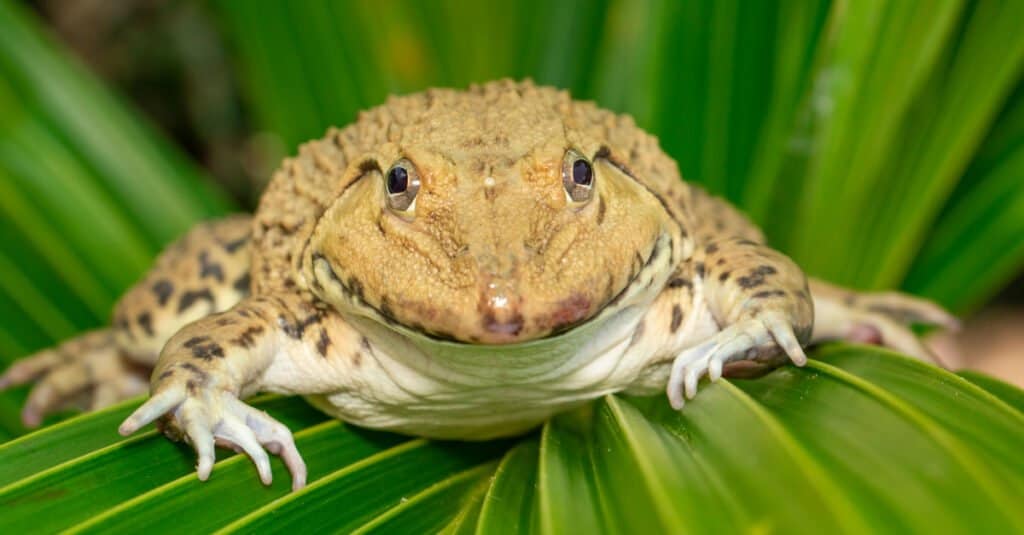
In wet markets and seafood markets, Chinese Edible frogs are sold widely.
©yod 67/Shutterstock.com
Chinese Edible frogs are also known as the East Asian Bullfrog or Taiwanese Frog. They can grow up to 4.5 inches, with females the larger of the two. Chinese edible frogs appear in green, tan, or yellow. Some have ridges, warts, or a dark mottled pattern covering their back. Their stomachs are white or pale yellow. East and Southeast Asian countries are where this species lives. Open land near a freshwater source is their preferred habitat.
Size and availability are why they are eaten so often. In wet markets and seafood markets, they are sold widely. Their legs contain edible meat, but edible frogs are also popular pets within Asia. They are farmed in China, Malaysia, Thailand, and Sichuan, widely used for human consumption and pets.
6. Edible Bullfrog (Pyxicephalus edulis)
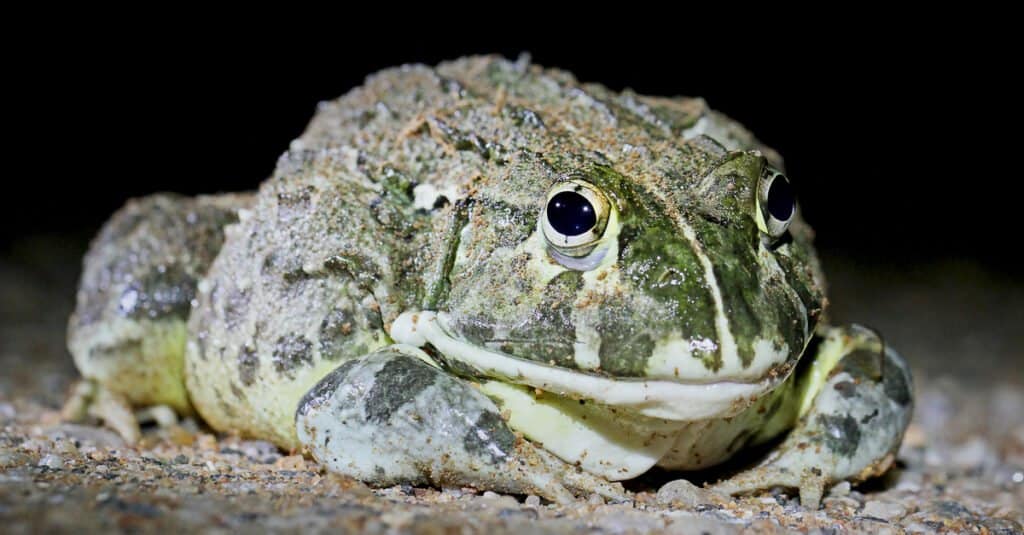
Edible bullfrogs can reach more than 5 inches.
©Eugene Troskie/Shutterstock.com
Edible bullfrogs are an African species of bullfrog. They prefer habitats with sandy clay-like substrates. Flooded grasslands, meadows, and marshes are habitats where this species lives. Like other edible frogs, this species is valued and named after its use as food. In some areas, their population has declined drastically due to being eaten so often.
Olive to light green is a common color for this species, with some frogs having a faint dorsolateral stripe running down their back. Other names for the edible bullfrog include lesser bullfrog, Peter’s bullfrog, and the Pixie frog. Pixie frog is also a name used for the African bullfrog, which this species sometimes gets confused for. Both frogs are a part of the Genus Pyxicephalus, but the Edible bullfrog is much smaller, with males growing up to 5.4 in. (13.8 cm). Females are smaller and may only reach half that size.
5. Asian Bullfrog ( Hoplobatrachus tigerinus)

Asian bullfrogs can reach up to 6.6 inches.
©ThulungPhoto.com/Shutterstock.com
Asian bullfrogs are just one name for Hoplobatrachus tigerinus; others include the Indus Valley bullfrog and Indian bullfrog. India, Nepal, Pakistan, Afghanistan, and other Southeast Asian countries are where this species is prominent. They have also become invasive in Madagascar and the Andaman Islands. Wetlands and areas with a permanent water source are habitats they inhabit. Water is mainly used for breeding. They hide in holes, under debris, and in vegetation on land.
Asain bullfrogs are nocturnal and will come out at night to feed. Their large size makes them capable of eating large amounts of animals like mice, insects, frogs, snakes, and small birds. Adults can reach up to 6.6 inches (16 cm) and have olive-green or gray coloring. Dark blotches appear on their back and legs. Their underside is white, and males have dark throats with inflatable vocal sacs.
4. American Bullfrog (Lithobates catesbeianus)
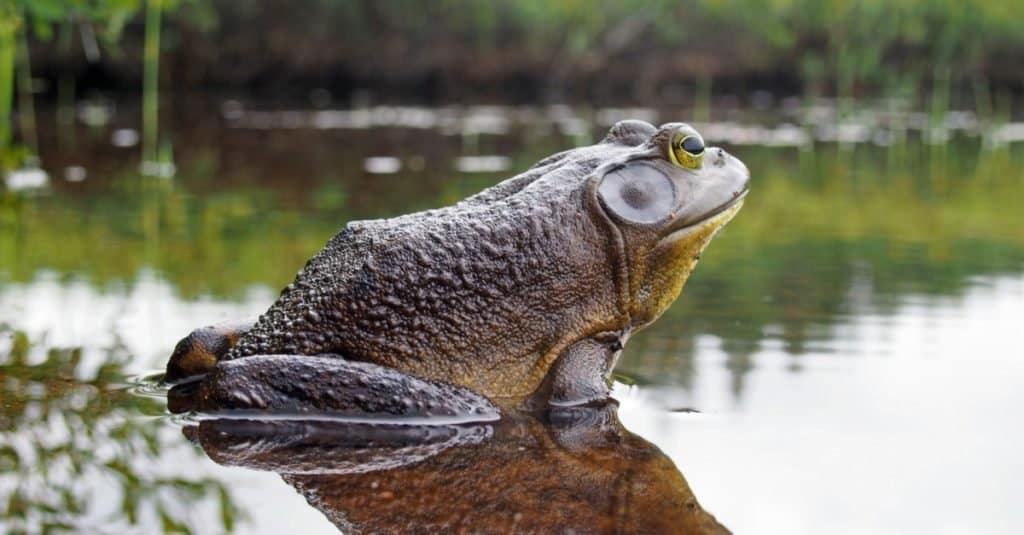
North American bullfrogs can measure up to 8 inches.
©Christian Ouellet/Shutterstock.com
American bullfrogs are also called North American bullfrogs and are endemic to the Eastern United States and parts of Canada. American bullfrogs are a highly invasive species and have found their way all over the U.S. and Mexico, South America, Europe, and Asia. Their large size and big appetite make them a dominant species wherever they find themselves. Lakes, ponds, rivers, and shallow freshwaters are preferred habitats.
Some American bullfrogs have been documented to reach around 8 inches and can weigh up to 3 lbs. They come in shades of green and brown, with blotches and spots covering them. American bullfrogs tend to dwindle the population of native species, as they will feed on them and eat their food source.
3. African Bullfrog ( Pyxicephalidae adsperusus)
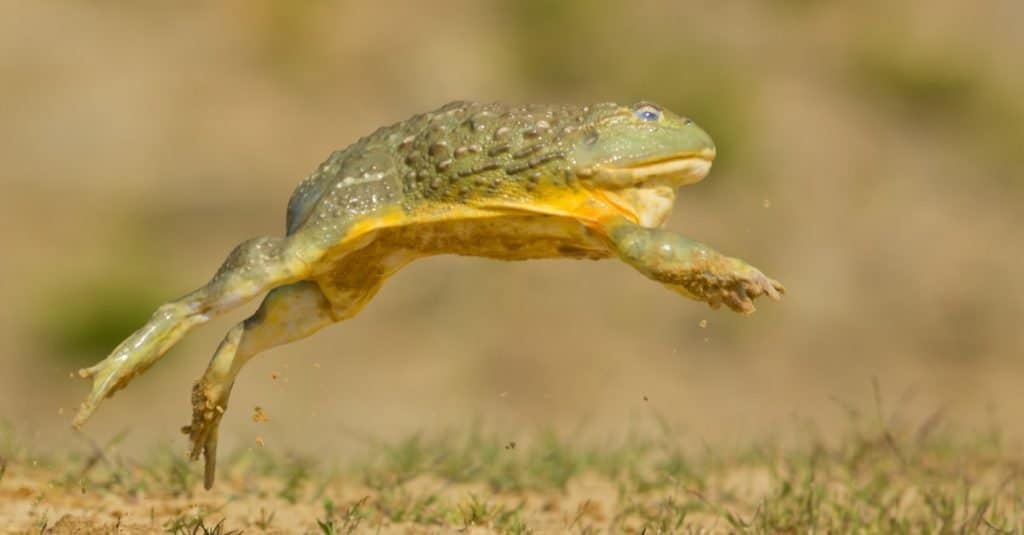
African bullfrogs can grow to 10 inches in length.
©Milan Zygmunt/Shutterstock.com
Giant African bullfrogs live in the southern half of Africa. South Africa, Kenya, Malawi, Namibia, Tanzania, and Zimbabwe are some countries they inhabit. Males are larger than females and can grow 10 inches (25cm). African bullfrogs have greenbacks with white or pale cream stomachs. Orange and yellow coloring appears on their sides. Large skulls and round bodies are noticeable features of this species.
African bullfrogs prefer moist conditions and will spend their time buried if temperatures are too dry or cold. Heavy rainfall brings this species out from underground and triggers them to breed. Their large size and variety of color patterns make them a popular pet to own. Docile nature, easy-care routine, and a lifespan of over 20 years make them one of the best frog species to keep as a pet.
2. Chilean Helmeted Bullfrog (Calyptocephalella gayi)
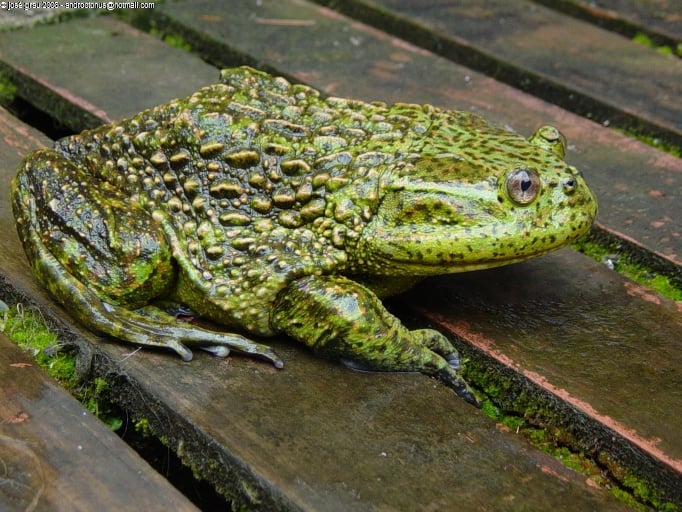
Chilean helmeted bullfrogs will prey on anything they can overpower and fit into their mouths.
©José Grau de Puerto Montt /CC BY-SA – License
The Chilean helmeted bullfrog, also known as the helmeted water toad or wide-mouth toad, is a South American species in Central Chile. They are the world’s second-largest frog, growing 12.5 in (32 cm) large. Helmeted toads are yellow, green, and brown, turning gray as they age. Fish, invertebrates, birds, mammals, and frogs are animals this giant frog feeds on. They will prey on anything they can overpower and fit into their mouth.
This species is primarily found in freshwater habitats, as they are aquatic frogs. Their population is listed as vulnerable and declining due to disease, pollution, and hunting. Farms will breed this species for food but are still not enough to stabilize their population. Invasive species of African clawed frogs have also brought disease that dwindles the number of Chilean Helmeted bullfrogs.
1. Goliath Bullfrog (Conraua goliath)

Goliath frogs can reach 12.6 inches and weigh 7.3 pounds.
©meunierd/Shutterstock.com
Goliath frogs are the largest bullfrog species in the world, with a record length of 12.6 inches (32 cm) and a weight of 7.3 lbs. The goliath frog is also the largest frog species in the world. They live in Africa, within the rainforests of Cameroon and Equatorial Guinea. This frog has a small range and population. Goliath frogs are listed as Endangered due to habitat loss and the collection of specimens for food and pet trading.
Crocodiles, snakes, and humans hunt the Goliath frog in the wild. Rivers with dense vegetation and humid temperatures are needed to survive. They feed on birds, small mammals, and other animals they come across. Tadpoles of this species only feed on podostemaceae, which are only grown in fast-moving waters within their range. Preserving their habitat is crucial, as not many areas exist that are suitable for this giant species. Being kept in zoos and terrariums is one way this species is trying to be preserved, but they have not been able to breed in captivity.
Summary of the 10 Largest Bullfrogs In The World
Here’s a summary of the 10 largest bullfrogs, how large they get, and where they are located:
| Number | Frog | Length | Location |
|---|---|---|---|
| 1 | Goliath Bullfrog | 12.6 inches | Africa |
| 2 | Chilean Helmeted Bullfrog | 12.5 inches | Central Chile |
| 3 | African Bullfrog | 10 inches | Southern Africa |
| 4 | American Bullfrog | 8 inches | Eastern U.S. |
| 5 | Asian Bullfrog | 6.6 inches | Southeast Asian countries |
| 6 | Edible Bullfrog | 5.4 inches | Africa |
| 7 | Chinese Edible Frog | 4.5 inches | East and Southeast Asia |
| 8 | Crowned Bullfrog | 4 inches | sub-Saharan Africa |
| 9 | Jerdon’s Bullfrog | 3.9 inches | eastern India, Sri Lanka, Nepal, and Bangladesh |
| 10 | Giant Banjo Frog | 3.5 inches | Eastern India, Sri Lanka, Nepal, and Bangladesh |
The photo featured at the top of this post is © ThulungPhoto.com/Shutterstock.com
Thank you for reading! Have some feedback for us? Contact the AZ Animals editorial team.






